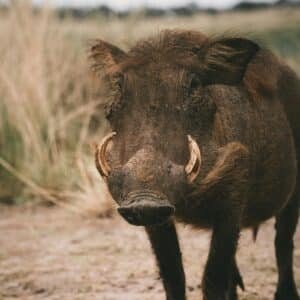
HOGS
FUN FACT
Feral hogs caused an estimated $2.5 billion in damage across the U.S. in 2023.
Schedule Your Feral Hog RemovalCall (512) 764-5804Identification
Wild hogs, also known as feral hogs, are increasingly problematic across the United States, with their population numbers estimated in the millions. These adaptable creatures thrive in various habitats, including forests and agricultural lands. Wild hogs are omnivores with a voracious appetite, consuming plants, insects, and carrion. In Texas, their presence has expanded from farms and ranches to neighborhoods and backyards.
Signs of Infestation
- Root Damage: Distinctive overturned soil from rooting for food.
- Damaged Crops: Significant damage to gardens, crops, and lawns.
- Mud Wallows: Created for cooling and parasite removal.
- Dead Animals: Prey on smaller animals, such as deer fawns.
- Damaged Fencing: Break through fences, rip down barbed wire, or break through structures.
Breeding Season
Wild hogs have a flexible breeding season, typically occurring in late fall and winter. Gestation lasts about three months, resulting in litters of 4 to 12 piglets. Sows can reproduce multiple times a year, with young reaching sexual maturity by the following year.
Ecosystem Role
Despite their destructive nature, wild hogs play a small role in the ecosystem. As omnivores, they help control populations of insects, rodents, and other small animals. They also contribute to seed dispersal by consuming fruits and nuts and depositing the seeds in new locations.
Prevention Strategies
- Secure Food Sources: Store all food, including pet food, in airtight containers and avoid leaving food scraps or garbage exposed.
- Remove Attractants: Clean up fallen fruit and remove bird feeders.
- Fencing: Construct a sturdy fence at least 4 feet tall and buried 6 inches underground.
- Repellents: Use commercial repellents based on hot pepper or predator urine.
- Habitat Modification: Remove brush piles and potential hiding spots.
- Trapping and Relocation: Conduct trapping and relocation under the guidance of wildlife professionals.
Prickly Pear’s Approach
- Inspection: Identify signs of wild hog activity and potential entry points.
- Exclusion: Implement barriers and secure food sources to prevent hog access.
- Humane Removal: Safely and humanely remove wild hogs from your property.
- Follow-Up: Regularly monitor and adjust strategies to keep wild hogs away.
Conclusion
Wild hogs, with their destructive habits and rapid reproduction, pose significant challenges to property owners. Prickly Pear offers professional services to manage wild hog activity and protect your property. If you suspect a wild hog problem, contact us for expert assistance in reducing their impact and maintaining a balanced ecosystem.
